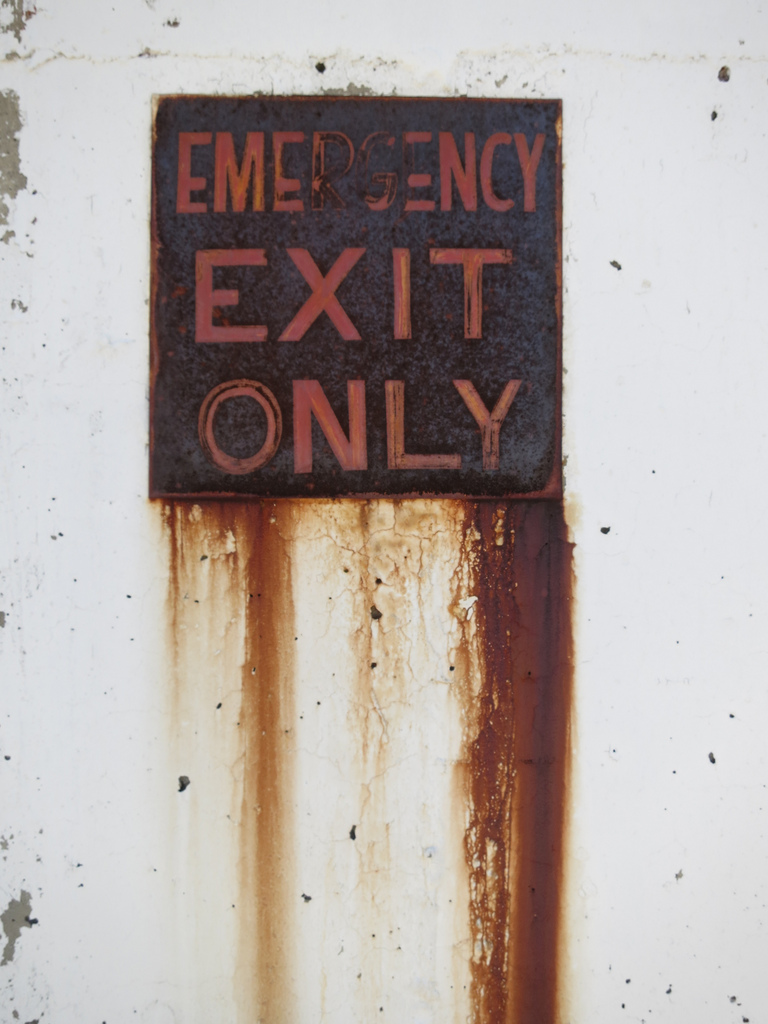Do your employees know how to handle a crisis at workplace? Is your office’s emergency preparedness plan adequate?

Emergency exit signs should be much more visible than this one. From Paul Sableman.
OSHA defines workplace emergency as “an unforeseen situation that threatens your employees, customers, or the public; disrupts or shuts down your operations; or causes physical or environmental damage.” It is important for employers to see whether a workplace is fully equipped to handle every kind of emergency, and if not, plan adequately for a timely response to these emergencies.
Workplaces lacking in emergency preparedness
An online poll, conducted by Cintas Corporation, reveals that less than a third of employed U.S. adults (31 percent) consider their workplace proactive about emergency preparedness. The poll surveyed 2,019 employed US adults, aged 18 years and older.
More than three-quarters of the participants said that no emergency drill for weather-related disasters had been conducted in their workplaces. Only 43 percent pointed out that their workplace has an emergency response plan in place. A mere 19 percent indicated that their workplace had involved employees as part of an emergency response team.
“Our survey highlights a gaping hole in organizational preparedness,” said Jamie Samide, Senior Director of Marketing, Cintas. He adds, “Since many employed adults spend the majority of their waking hours in the workplace, organizations need to be prepared to handle injuries, health emergencies or inclement weather with both proactive and reactive solutions.”
Prepare your workplace for an emergency
According to OSHA specifications, almost all businesses need to have an Emergency Action Plan (EAP) in place. At a minimum, employees should at know how to evacuate the building safely and gather at designated assembly points until they get the all clear signal.
Trained staff and volunteers can do wonders during an emergency. Apart from assisting clients and visitors towards the exit routes, they can also guide emergency personnel in locating key safety equipment to bring the situation under control.
The Red Cross provides flexible training options that meet OSHA and other regulatory standards, so that organizations can choose the ones that best meet their requirements.
Emergency planning tips
To adequately prepare your workplace for an emergency, you must:
- Assess risks and identify appropriate controls and protective equipment to safeguard employees against potential harm.
- Designate assembly areas where employees should gather after evacuating.
- Mark the location of first-aid kits and fire extinguishers, and post a list of emergency services numbers (including numbers for ambulances, police, and the fire department) near each telephone.
- Designate and mark well-lit and unobstructed primary and secondary evacuation routes and exits.
- Underline procedures for assisting people with disabilities and people who do not speak English.
- Select a few employees to train in CPR and other rescue and medical duties.
Bob Boyd, president and CEO of Agility Recovery—a company that develops workplace disaster preparedness plans—says that a workplace emergency can be anything ranging from a natural disaster like a hurricane, or everyday occurrences like a burst pipe in your office, a piece of technology that fails, or a power outage. He adds that planning out an alternative workplace, prioritizing key functions, keeping key vendors and communication lines up and running are vital factors that should be kept in mind while working out an emergency plan.
Whether you work in a high rise, a park, or a warehouse, be sure to have an EAP to suit your facility’s needs. Always remember—a good emergency preparedness program can go a long way in averting possible disaster.